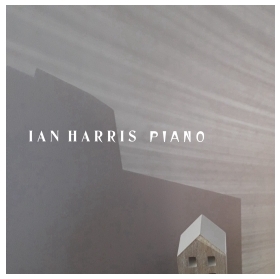
P i a n o
Piano music composed and performed by Ian Harris
LISTEN / BUY at Bandcamp
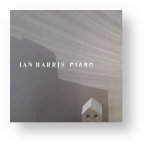
released June 16, 2021
1. The Black Gondola 02:42
2. Clouds and Life 04:15
3. The Enchanted Chandelier 03:16
4. Falling Leaves at Loch Oich 04:39
5. Grey Autumn 03:23
6. Miroirs d'illusion 03:47
7. New Winter Sky 04:52
8. The Quiet Snow 05:04
9. Reflections at Midnight 03:32
10. Summer Blue 03:51
11. Winds of Tibet 04:22
12. The Changing Sky 02:58
13. Nansen 04:59
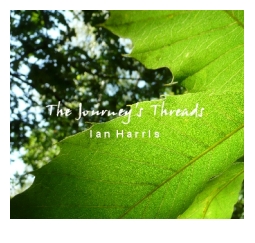
The Journey's Threads
(2014)
Classical and Jazz fuse in this ethereal vocal and instrumental music. 7 pieces of music featuring the counter tenor voice of Daniel Tucker and the violin playing of Michael Peck, combined with the piano, classical guitar, vocals and electronics of Ian Harris. An album that moves from breathtaking simplicity to dazzling virtuosity.
Ian Harris - piano, classical guitar, vocals & electronics
Daniel Tucker - counter tenor
Michael Peck - violin
"elite and polished"
Kelly O’Neil, Review You
“the overall
impression left by this work is that of beauty”
Dan MacIntosh, Review
You
“musical craftsmanship and thoughtfulness”
Alex Henderson, Review You
1. Over Ice Land 3'53
counter tenor - Daniel Tucker
piano, vocals, electronics - Ian Harris
violin- Michael Peck
2. Between White Clouds 3'50
piano, vocals, electronics - Ian Harris
violin - Michael peck
3. Walking Towards The Rainbow 3'27
piano - Ian Harris
4. Of The Loss Of Time 4'01
counter tenor - Daniel Tucker
violin - Michael Peck
electronics, keyboards - Ian Harris
5. Journey To The Horizon 5'37
violin - Michael peck
piano - Ian Harris
6. L'espoir d'été 3'10
piano, vocals, electronics - Ian Harris
violin - Michael Peck
7. Song Of The Trees 6'10
violin(s) - Michael Peck
classical guitar, electronics - Ian Harris
BUY at iTunes
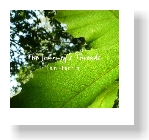
"There are some classical music aficionados who are averse to the atonal tendencies of many modern
compositions. Pianist Ian Harris
however, has masterfully counteracted this trait with his clever inclusions of
aurally pleasing tones and placid sparkle. On the Britain’s second album The Journey’s Threads he once again
works with counter tenor Daniel Tucker and violinist Michael Peck.
The opener “Over Ice Land” is
hauntingly beautiful with its stark mysterious aura. Tucker’s vocals are lovely and ethereal with Peck and rustic
flute calls echoing in the distance. Harris lends his vocals in the latter half of the song with his warmth
nicely complementing the celestial counter tenor. The mostly instrumental “Between White Clouds” takes the romantic
notion of painting the aural picture the title implies, yet Harris’ rendering
is more sophisticated. The delicate
bells and electronic noises he employs around his piano work are like the wispy
silver linings of the clouds. Peck’s
violin statements are thither and gone like a gentle gust. In the final portion of the song, Harris’
tender vocals sing the title. “Walking
Towards the Rainbow” is a quiet piano solo that begins with a melodic idea
twice stated, as if to build up the gumption.
Then Harris gently and ever so subtly plays an eighth note journey of
rises and falls like footsteps on a garden path, yet as glistening as the water
from a stream flowing over smooth pebbles.
The listener can become so absorbed that the ending seems to sneak up.
Water is actually heard along
with mechanical gears in the onset of “Of the Loss of Time,” whose lyrics are
taken from the Elizabethan poet John Hoskins’ work of the same title. Harris mixes synthesized strings with Peck
while Tucker chants in this more modern sounding piece with no clear tempo and
long pauses. Each musical idea is
independent yet with the echo and the counter tenor’s legato vowelizations
there is a shroud of mist that encompasses and binds the song together. More direct is the violin and piano
conversation in “Journey to the Horizon.” Harris and Peck at times sound like they are playing in different key
signatures, yet the two instrumentalists deliberately and expertly continue
their statements exhibiting excellent dynamics and musicality.
“L’espoir d’été” loosely
translates to “the hope of summer” and Harris plays a cheery lead on piano adorned
with violin, bells, triangle and synthesized bass guitar sachets. His lovely grace notes on the keys and
overlaid vocals at the end harbour tranquility. The most mesmerizing piece on The Journey’s Threads is the violin
featured “Song of the Trees.” Peck is
multi-tracked playing different voices crying their own lament, yet they all
fit into each other by a greater design, like the giant canopy of an
antediluvian forest. Harris plays
classical guitar adding structure and a glint of sunshine as it pours down into
the depths and touches the golden branches beneath the thick leaves. Faint electronic pings undulate quietly as
the song hypnotically melds all the musical voices in and out of each other
until finally fading away.
Harris has been an avid
composer for over fifteen years. Therefore it is not surprising how elite and polished The Journey’s
Threads is. The composer’s unique instrument
pairings and shrewd melodic weavings can easily bring modern music to a wider
and more appreciative audience."
Reviewer: Kelly O’Neil, Review You
Rating: 4 stars
The music found on The Journey’s Threads involves the three-fold combination of counter tenor Daniel Tucker’s vocals, Michael Peck’s violin and Ian Harris’ piano and various electronic instrumentation. It’s a 7-song release that veers among jazz, classical pop and what used to be termed new age music.
This album, however, is under Harris’ name. Harris is both a composer and a video artist based in the UK. He’s a trained visual artist, with a BA in Fine Art, as well as a scholarly musician with an MA in music. One of his more fascinating past works is the music he created for a 2001 film version of a Thomas Mann novel, which was broadcast on BBC Radio 3. He’s also worked on orchestrations for multi-instrument performances, some of which were presented at the famous spiritual event, Greenbelt Festival.
The album’s most classical sounding track is one titled “Walking Towards The Rainbow.” It’s a mid tempo piano piece that clocks in at 3:29. For whatever reason, it conjures up images of an Irishman searching for that pot of gold at the end of the rainbow. Maybe it’s the word ‘rainbow’ in the title that brings such stereotypical pictures to the mind. Nevertheless, it’s a pretty tune and quite a meditative one.
“Of The Loss Of Time” makes excellent use of Tucker’s vocals, as his voice simply soars over the instrumental section of the piece. This track is music put to a poem by John Hoskins, who was not only a writer of poems, but also a scholar of Greek, a lawyer, judge and politician. It’s interesting to hear the way Tucker’s voice plays off Peck’s violin on this one. It’s a credit to Tucker’s singing ability that many times the listener may have trouble aurally discerning the difference between the vocal parts and the string parts. Tucker is such a spot-on singer when it comes to hitting the right notes; there are portions when his vocal and Peck’s violin blend together nearly seamlessly. This is fascinating, and likely one of the probable reasons Harris chose to include both of these two artists on his project.
“Journey To The Horizon,” on the other hand, is an excellent collaboration between Harris and Peck. This one leans particularly close to the jazz spectrum of the stylistic continuum, as both Harris and Peck trade notes throughout. It leaves the overall impression of a jazz standard, only performed instrumentally.
“L’espoir d’ete,” is a slow, thoughtful piece. The project's finale, “Song of the Trees,” multi-tracks the violin for both a beautiful and mysterious creation. One imagines environmentalism is near and dear to Harris’ heart, as the cover photo on his album is a close-up of a very green leaf. The inside cover pictures a similar leaf, only this time a red one.
Although it’s difficult to pick out just one theme intended for this project, nature is one of its bigger ones. In addition to the aforementioned “Song of the Trees,” along with the leaf photography utilized in the CD’s artwork, the land is mentioned in “Over Ice Land,” clouds come up with “Between White Clouds” and God’s amazing natural invention, the rainbow, plays into “Walking Towards The Rainbow.”
The overall impression left by this work is that of beauty. Beauty that is consistently found in nature, matched with beautiful music likely intended to reflect nature’s beauty. Rock and pop music fans may be hesitant to investigate an album such as this one that prominently features a counter tenor singer in its credits. For many, the very thought of a classical participant might give them cause to hesitate. However, once you hear what these three talented musicians have created together, your prejudices will likely disappear like a vapor.
Reviewer: Dan MacIntosh, Review You
Rating: 4 Stars (out of 5)
Those who haven’t listened to a lot of new age releases might think of new age as a genre that is electronic 100% of the time. But while it is true that some new age recordings rely on electronic programming exclusively, that is by no means true of all new age recordings. Many other new age albums have successfully combined the electronic and the acoustic. On such albums, electronic programming and synthesizers are likely to be used alongside acoustic piano, acoustic guitar and acoustic violin or, in some cases, traditional world music instruments such as the Indian sitar, the Turkish saz, the Arabic oud or the African kalimba. And on The Journey’s Threads, U.K.-based pianist, guitarist, composer, producer and vocalist Ian Harris not only blends the electronic and the acoustic: he gives acoustic instruments the upper hand.
Some electronic programming is used on these tranquil, peaceful performances, but truth be told, it is electronic programming in service of acoustic piano, classical guitar or acoustic violin. Acoustic instruments dominate this 2014 release (which is devoted to Harris’ compositions exclusively), and Harris’ use of electronics is an attractive side dish rather than the main course. There are three participants on The Journey’s Threads: Harris (acoustic piano, classical guitar, vocals, and electronics), Michael Peck (acoustic violin) and Daniel Tucker, who provides some additional vocals on “Over Ice Land” (as opposed to “Over Iceland”) and “Of the Loss of Time.” And all three of them do their part to give The Journey’s Threads a warm, organic type of sound. This is the sort of new age album that sounds a lot more played than programmed, and Harris’ material never sounds stiff or mechanical
But melodically and harmonically, The Journey’s Threads is still quite faithful to the new age aesthetic. New age albums are typically known for expressing a tranquil, peaceful sort of spirituality, and this 30-minute CD fits that description whether vocals are being offered on “Over Ice Land,” “Between White Clouds,” “Of the Loss of Time” and “L’Espoir d’Été” (which means “The Hope of Summer” in French) or an instrumental approach is being taken on “Journey to the Horizon,” “Walking Towards the Rainbow” and “Song of the Trees.”
Harris’ ethereal work incorporates a variety of direct or indirect influences, ranging from jazz to the mellower side of progressive rock (as in the Moody Blues) to European classical music.The violin has a long history in the European classical tradition, and Peck is clearly mindful of classical violin when Harris features him on “Journey to the Horizon” and “Song of the Trees.” Meanwhile, Harris’ acoustic pianism hints at both Euro-classical piano and post-bop jazz piano on “L’Espoir d’Été,” “Over Ice Land” and “Walking Towards the Rainbow.” Harris sounds like the type of acoustic pianist who could have some Keith Jarrett in his CD collection along with performances of Beethoven and Chopin’s works.
Harris’ publicity bio mentions that he composes music for independent short films and that his own films “have been screened at various festivals, galleries and events in the UK and Europe.” Listening to The Journey’s Threads, one can easily picture Harris’ compositions being used in an independent film setting. However, the seven selections on this CD work well on their own without any type of visual stimulation. One can sit down, close his/her eyes and easily appreciate the musical craftsmanship and thoughtfulness that went into The Journey’s Threads. Some new age recordings can come across as shallow, but it is clear that Harris is going for depth and put a great deal of thought into this project. The Journey’s Threads is worth checking out if one appreciates the more organic, less programmed side of the new age genre.
Reviewer: Alex Henderson, Review You
Rating: 3
stars (out of 5)
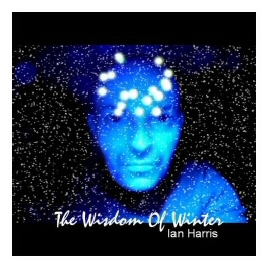
The Wisdom Of Winter
(2009)
"A beautiful and enchanting CD. A collection of nine songs and three instrumental pieces that explore inner and outer landscapes. Tinged with sadness, yet creating a haunting and unique sound-world."
Ian Harris vocals, piano, keyboards & electronics
Edith Peck vocals
Michael Peck violin
Matthew Tucker flute
Andrew James spoken voice
REVIEW:
written by James Crickmay
"This introverted adventurer, Ian Harris, crosses boundaries between high-minded classical, swooning song craft, cinematic styles and inklings of the ambient. Sucking in genres is one thing; developing your own substantially romantic sound-world is another. But Harris achieves this and more."Step in" and, listen by listen, you will listen in wonder. The interplay of piano/strings/violin/flute is precise yet unpredictable. The surface decoration, embellishment and "xylophonica" seems to rise
organically from the infrastructure. The violin dances like some unnameable insect, who in recognition of this highly photogenic sound has woken from extinction, fresh and stinging. And between reflectiveness and rapture, bliss and melancholic introspection, Harris breezes in with a vocal of alien serenity; outwardly calm but containing a storm of emotion and words of longing. Similes relating to light are hard to avoid here-dazzling, searching, the starlit female voice of Night Song. For the signature motif
of The Wind, it seems that Harris has managed to record a sunbeam and bend it into the bite size opening bars of a theme familiar only to the ears of prophets. From his imagination Harris creates ideas which create music that creates songs which create pictures that create a world that creates a language which creates more ideas through which he can express his emotions."